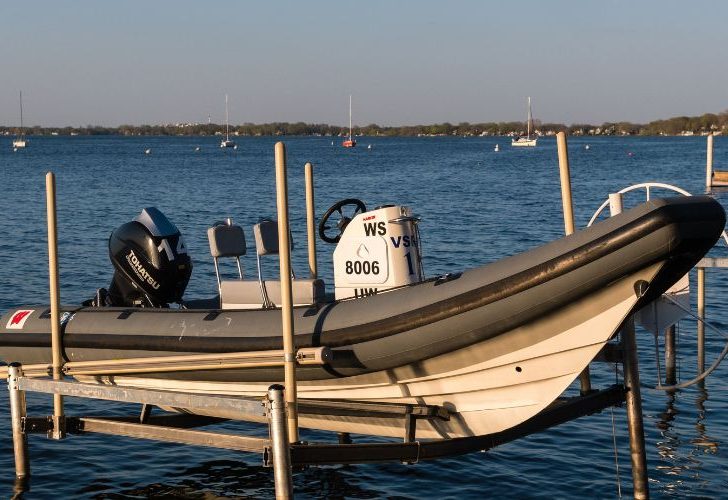If you’re in the market for a new rigid inflatable boat, you may be wondering about the different kinds available. Specifically, you’ve heard that many RIBs are made of either aluminum or fiberglass.
Aside from the materials used to make them, what are some of the major differences between these types of boats?
Which one is stronger? Which one lasts longer?
Are there any alternatives to both aluminum and fiberglass?
And how do you decide which type of RIB is right for you?
Great questions!
Read on to learn more!
Table of Contents
What is an Aluminum RIB Boat?
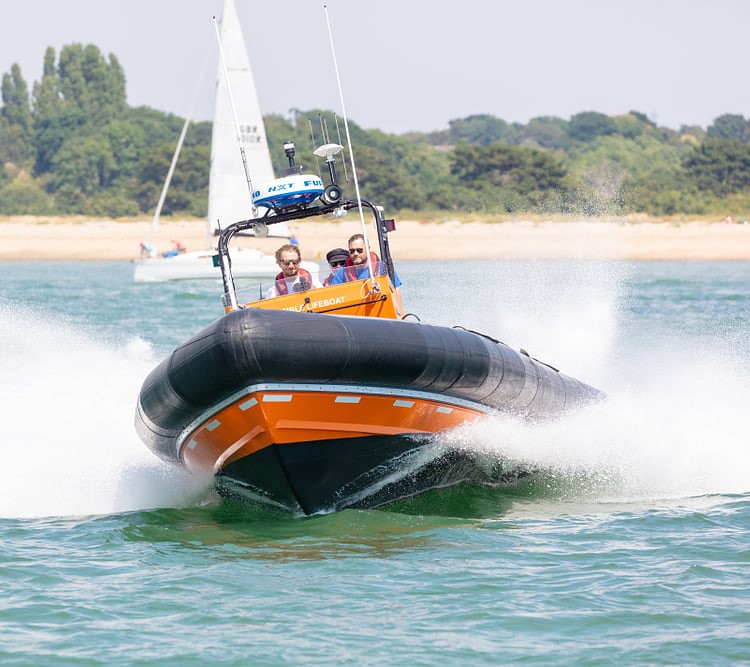
As you might imagine, aluminum RIB boats have aluminum hulls.
Of course, this means that, though the boat has inflatable sponsons, the rigid base of the boat is made of aluminum.
The hull is usually a single piece, but models that break down for storage are also available.
RIB hulls made of aluminum are exceptionally lightweight. In fact, because of their lower overall weight, they are easier to carry and more fuel-efficient than fiberglass boats.
One of the biggest benefits of aluminum is that it’s tough.
Aluminum RIBs can bend, but they are almost impossible to break, so they can handle a variety of collisions and impacts while suffering only minor dents and scratches.
The primary drawback of aluminum is that it’s not the best option for use in saltwater. If you plan to use an aluminum boat in saltwater, you’ll first need to prime it with aluminum-safe antifouling paint, which can be expensive and time-consuming to apply.
Aside from keeping them safe from saltwater, aluminum boats don’t need a lot of maintenance, so they are convenient to use and don’t require you to put in a lot of time to keep them functioning at their best.
Because aluminum RIBs are both lightweight and durable, they are great for a range of uses, from freshwater fishing boats to tactical rescue boats.
What is a Fiberglass RIB Boat?
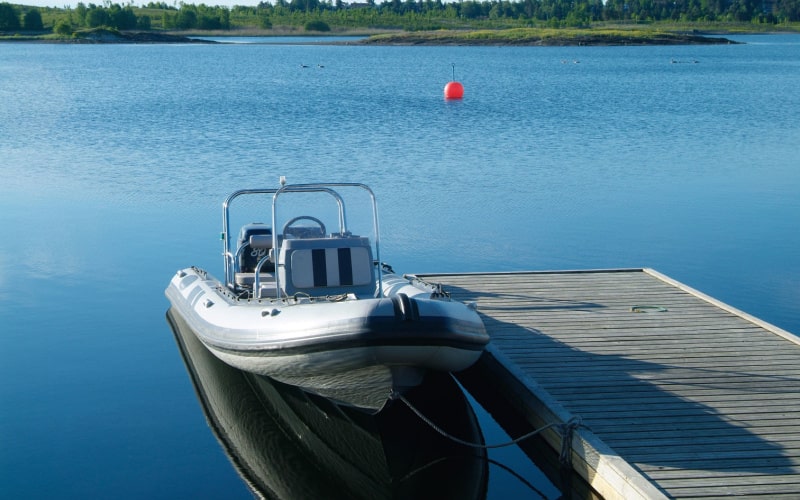
As you might expect, fiberglass RIBs have hulls made of fiberglass. The process of manufacturing fiberglass RIBs takes time and effort because the fiberglass has to be molded. The longer manufacturing time generally makes them more expensive than aluminum RIBs.
That said, fiberglass RIBs can be molded into many different shapes, sizes, and styles, making them more diverse. For this reason, they are also more easily customizable than aluminum RIB boats.
Fiberglass boats are heavier than aluminum, so they aren’t as fuel-efficient or convenient to transport. However, they are the best choice for saltwater use, as the salt water won’t corrode the fiberglass as quickly and the antifouling paints used are cheaper for fiberglass hulls.
Fiberglass is prone to becoming brittle and cracking if you don’t keep your hull properly maintained. The hull may also crack on impact, so fiberglass boats shouldn’t be used in areas where there’s a risk of scraping the bottom or encountering rocks.
Though fiberglass RIBs require regular maintenance, they are generally cheaper to repair than aluminum boats, and the repairs may be easier to make as well.
Aluminum or Fiberglass: Which is Stronger?

So now that you know the difference between aluminum and fiberglass boats, you may wonder: which type of RIB is better? Specifically, which one is stronger? Which one takes a beating with the least amount of damage?
As a rule, aluminum is about 10 times stronger than fiberglass.
So, when it comes to impacts, aluminum boats are much stronger than fiberglass boats–as noted above, they will bend, scratch, and dent, but they will rarely break.
However, when it comes to exposure to the elements, fiberglass will probably be the stronger material. Saltwater will corrode and damage aluminum boats more quickly than fiberglass boats.
So, it all comes down to how you plan to use your boat: for freshwater and high impact situations, aluminum is best; for saltwater and low impact situations, fiberglass is best.
Aluminum or Fiberglass: Which Lasts Longer?
We now know which material is stronger under given circumstances, but that may not fully answer your question. Perhaps you’re still wondering: which type of boat lasts longer?
Unfortunately, there’s no one-size-fits-all answer to that question. Both aluminum and fiberglass RIBs have their strengths and weaknesses, and how long each type of boat will last depends largely on how you maintain and use it.
In general, aluminum boats last longer than fiberglass unless they are frequently used in saltwater and not cleaned or maintained properly. They last longer because they are stronger and less prone to breaking, thus requiring less maintenance.
That said, fiberglass boats can last a long time as long as they are properly cared for and kept away from high-impact situations. They are also a much better choice for saltwater and will last longer than aluminum boats if you are frequently out in the ocean.
Aluminum Vs. Fiberglass: Breaking it Down
So now, let’s take a closer look at some specifics. Which type of boat is easier to use? Which one works better? Is more affordable? Safer? And are there any good alternatives to both aluminum and fiberglass RIBs?
Ease of Use
Both aluminum and fiberglass boats are easy to use. Aluminum boats are lighter, so for some people, they may be easier to transport to and from the water.
That said, aluminum boats produce more noise in the water–waves lapping against the sides of your boat create a metallic ringing noise more pronounced than fiberglass boats. Some people may find this extra noise extremely annoying.
It’s also worth noting that fiberglass boats tend to be more aesthetically pleasing because of how they are molded. They also typically have more storage space than aluminum boats.
Which Works Better?

Because they are so lightweight, aluminum boats tend to be quick in the water and very fuel-efficient. And, because they are strong, they can handle impacts from shallow or narrow waterways better than fiberglass. They are, in a sense, the best of both worlds.
For this reason, aluminum boats work better in rivers, streams, and ponds than fiberglass boats.
Of course, fiberglass boats have their own set of pros.
They are heavier, but they are better for use in saltwater because they are easier and cheaper to apply antifouling paint to. Also, their added weight can be a good thing in ocean waters: it gives them a better ability to handle larger waves as you might face in the ocean.
Affordability
Aluminum boats are almost always more affordable than fiberglass boats. This is because they are easy and cheap to manufacture–aluminum is inexpensive and doesn’t have to be shaped by custom molding.
Fiberglass boats typically need ongoing maintenance to repair small cracks and breaks in the hull. These maintenance costs will add up over time, adding to the already higher expense of buying a fiberglass boat.
Of course, for saltwater use, aluminum boats may end up costing more to maintain due to the price and availability of the proper antifouling paint.
Safety
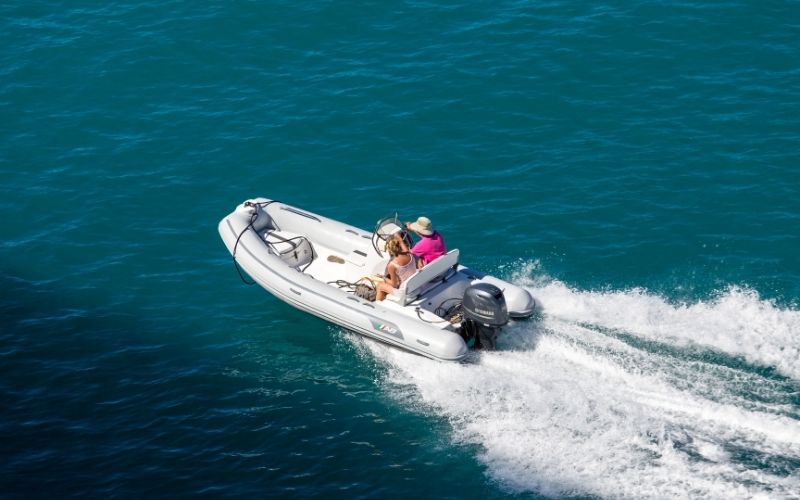
Both aluminum and fiberglass RIBs are safe on the water as long as they are properly maintained and operated. All RIBs are generally safe because they are virtually unsinkable.
Aluminum boats may have a slight edge over fiberglass simply because they are much harder to break, so they are less likely to spring a leak while you’re on the water.
That said, the most important thing is to understand and practice safety measures while you’re in the boat. Make sure you and all your passengers are wearing lifejackets, stick to calm waters and be aware of your own skill level at all times. Don’t take any more risks than necessary.
Alternatives
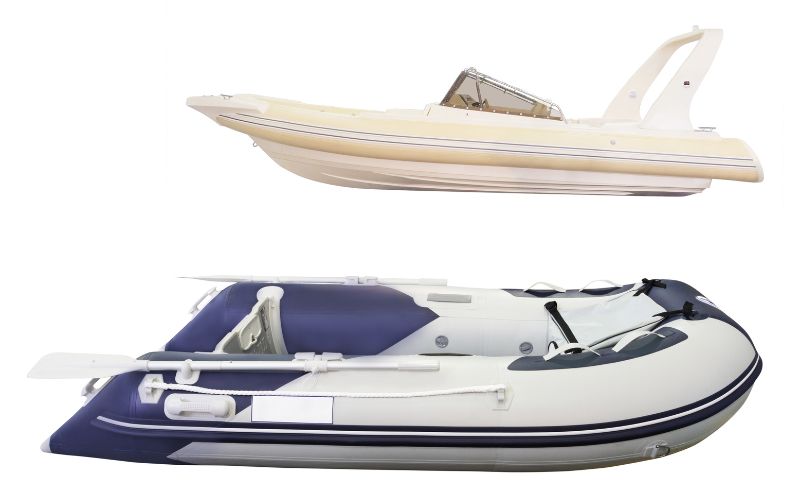
If, after reading all the other information in this article, you’re not sure whether you want an aluminum or fiberglass RIB, you may be wondering if there are any other options. Let’s take a quick look at some alternative types of inflatable boats you might consider:
- Steel-hull RIBs: Some RIB boats are made with steel hulls. These are some of the strongest RIBs available, and they are nearly indestructible. As you might imagine, though, they are expensive and heavy.
- Wood-hull RIBs: RIB boats with wood hulls are fairly heavy and require a lot of maintenance, but they can make for very beautiful and functional boats.
- Inflatable dinghies: Inflatable dinghies are smaller boats with inflatable chambers. Some have rigid floors like RIBs, while others have inflatable floors. These small boats are a good choice for beginning boaters starting out on small ponds and lakes.
- Other inflatables: There are many inflatable boats–kayaks, pontoons, rafts, and canoes. Some are only large enough for one or two passengers, while others can carry a large group several miles out in the ocean.
Conclusion
By now, you should have a good working knowledge of what aluminum and fiberglass RIBs are, as well as many of the key differences between them. Hopefully, after reading the information in this guide, you’ll be able to choose the best type of RIB for your unique boating needs.

Sarah Hood has been writing for Anchor Travel since 2021. When she’s not writing, she enjoys cooking, singing, and spending time in the great outdoors.

